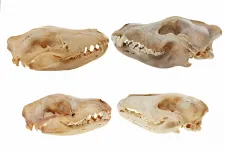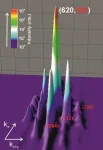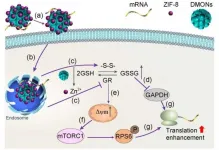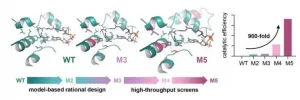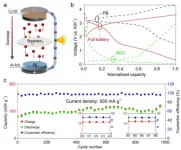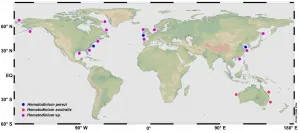(Press-News.org) Leading research at Newcastle University has been used to shape how dentistry can be carried out safely during the Covid-19 pandemic by mitigating the risks of dental aerosols.
It is well known that coronavirus can spread in airborne particles, moving around rooms to infect people, and this has been a major consideration when looking into patient and clinician safety.
Research, published in the Journal of Dentistry, has led the way in helping shape national clinical guidance for the profession to work effectively under extremely challenging circumstances.
The findings have been used by the Dental Schools' Council, Association of Dental Hospitals and the Scottish Dental Clinical Effectiveness Programme to guide key Covid-19 policies for the profession.
Research findings
Research revealed that aerosol generated procedures - such as fillings and root canal treatment - can spray aerosol and saliva particles from dental instruments large distances and contamination varied widely depending on the processes used.
In the open clinic settings, dental suction substantially decreased contamination at sites further away from the patient, such as bays five meters away. Often these distant sites had no contamination present or if contamination was detected it was at very low levels, diluted by 60,000 - 70,000 times.
It was also found that after 10 minutes, very little additional contaminated aerosol settled onto surfaces and therefore is a suitable time to clean a surgery after an aerosol-generating procedure.
Dr Richard Holliday, NIHR Clinical Lecturer in Restorative Dentistry at Newcastle University, UK, said: "Our research has improved our understanding of dental aerosol generated procedures and identified how cross-contamination could be a risk for spreading Covid-19.
"When the pandemic began, dental services were significantly reduced and there was an urgent need by the profession to focus on how dental clinics could work in a safe environment for patients and staff.
"We now have a much greater understanding of where the splatter of aerosols go and how far they travel during different procedures and settings, allowing clinical teams to make informed decisions to protect people.
"I am pleased that our research here at Newcastle has been used nationally by leading dental bodies to inform their policies on how the profession should carry out procedures during the pandemic."
Collaborative effort
A research team from the School of Dental Sciences, including clinicians, dental nurses, microbiologists and scientists carried out the study.
The team used the tracer dye, fluorescein, while carrying out aerosol-generating procedures on a dental mannequin to analyse how far and where aerosol particles and saliva travelled from the patient's mouth.
A range of procedures were done and the effect of suction and ventilation analysed. Experts looked at contamination close by and also in an open plan clinic.
Kimberley Pickering, a research dental nurse involved in the study, said: "For the safe re-opening of dental services, it was essential to understand the behaviour of the aerosols that come out of a patient's mouth during dental work.
"We now better understand where the aerosols go and how far they travel during different procedures and settings.
"We also understand how dental aerosols settle over time, which has helped inform cross-infection control procedures."
Further research will continue to focus on where aerosol and droplets from dental instruments travel and how far they go. Experts will also look at how long aerosols hang around in the air and examine a number of common dental procedures and methods of controlling aerosols.
A key part of the research will investigate if viruses can be carried in dental aerosols, and if viruses remain infective at a distance from the procedure. This will help experts to understand how to reduce the risk of microbes, like Covid-19, being spread by aerosols during dental treatment.
Student case study
The research led the team to develop a new clinic configuration to allow the safe return of dental students and their patients.
Newcastle University's School of Dental Sciences is one the first universities in the country to recommence teaching aerosol-generating procedures to students in person during the pandemic.
Fourth year student Paddy Crawshaw said: "Being a dental student during the pandemic has been a big challenge, but dental students feel lucky to come into University every day and get in-person teaching as it's a privilege to treat our patients.
"The Dental School has been very supportive since the pandemic began. It is clear that senior clinicians and academics have worked hard behind the scenes to allow us to return to clinical teaching.
"The common goal of delivering first-class treatment for our patients has enhanced the Dental School's sense of community and this has really helped me through this term.
"I am proud of the way Newcastle Dental School and all of its staff and students have come together in the face of adversity through the Covid-19 pandemic. To know we are one of the first schools in the country offering a full range of student-led treatments for our patients makes me feel lucky to be studying here.
"Due to the extensive research undertaken by the School I have never felt unsafe, whether extracting a tooth or doing a simple examination I know the School's protocols are allowing me to work safely."
INFORMATION:
Research
Evaluating contaminated dental aerosol and splatter in an open plan clinic environment: implications for the COVID-19 pandemic. Holliday R et al. Journal of Dentistry.
https://doi.org/10.1016/j.jdent.2020.103565
Micro-CT scanning and digital reconstructions have been used to compare the skulls of the Tasmanian tiger (thylacine) and wolf across their early development and into adulthood, establishing that not only did the thylacine resemble the wolf as adults, but also as newborns and juveniles.
"Remarkably, the Tasmanian tiger pups were more similar to wolf pups than to other closely related marsupials," Professor Andrew Pask from the University of Melbourne said.
The collaborative study with Flinders University and Museums Victoria complement earlier findings that thylacine and wolf have evolved ...
Artificial intelligence and machine learning are already an integral part of our everyday lives online. For example, search engines such as Google use intelligent ranking algorithms and video streaming services such as Netflix use machine learning to personalize movie recommendations.
As the demands for AI online continue to grow, so does the need to speed up AI performance and find ways to reduce its energy consumption.
Now a University of Washington-led team has come up with a system that could help: an optical computing core prototype that uses phase-change material. This system is fast, energy efficient and capable of accelerating ...
Topological materials are characterised by unique electronic and physical properties that are determined by the underlying topology of their electronic systems. Scientists from the Max Planck Institutes for Microstructure Physics (Halle) and for Chemical Physics of Solids (Dresden) have now discovered that (TaSe4)2I is the first material in which a charge density wave induces a phase transition between the semimetal to insulator state.
An international team of scientists at the Max Planck Institute for Microstructure Physics, Halle (Saale), the Max Planck Institute for Chemical Physics of Solids ...
Delivery of genetic molecules such as mRNA into cells is vital with important applications such as vaccine development. Various agents have been developed for mRNA delivery. However, conventional mRNA nanocarriers mainly focus on their physical interaction with mRNA molecules, or protection / delivery of mRNA, such as adjusting physical properties of nanocarriers to control binding with mRNA or cellular uptake. Moreover, effective mRNA delivery in hard-to-transfect APCs remains a challenge. The hard-to-transfect nature in APCs is partly attributed to the suppressed mRNA translation associated with the intrinsic high intracellular glutathione (GSH) level. Thus, ...
Photorespiration is a highly energy consuming process in plants that leads to the release of previously fixed CO2. Thus, engineering this metabolic process is a key approach for improvement of crop yield and for meeting the challenge of ever-rising CO2 levels in the atmosphere. Researchers led by Tobias Erb from the Max Planck Institute for Terrestrial Microbiology in Marburg, Germany, have now succeeded in engineering the TaCo pathway, a synthetic photorespiratory bypass. This new-to-nature metabolic connection opens up new possibilities of CO2 fixation ...
With the rapid development of smart portable electronics and electric vehicles, the consumption of lithium resource will increase dramatically and the cost of lithium-ion batteries (LIBs) may increase significantly in the future. In addition, the shortage (0.0017 wt% in the earth's crust) and uneven crustal distribution of lithium also limit its further development and application. As potassium (2.7 wt% in the earth's crust) have properties similar to lithium and abundant reserves. Therefore, as an alternative to LIBs, potassium ion batteries (PIBs) have become the focus of research. Potassium (2.92 V vs. ...
Scientists from the Max Planck Institute of Psychiatry, led by Nikolaos Koutsouleris, combined psychiatric assessments with machine-learning models that analyse clinical and biological data. Although psychiatrists make very accurate predictions about positive disease outcomes, they might underestimate the frequency of adverse cases that lead to relapses. The algorithmic pattern recognition helps physicians to better predict the course of disease.
The results of the study show that it is the combination of artificial and human intelligence that optimizes the prediction ...
The spiky structure that erupts from the smooth surface of a ferrofluid when a magnet is brought close can be predicted more accurately than previously thought. KAUST researchers have shown that computational algorithms can calculate the ferrofluid's bristling response to a magnet by simulating only the liquid's surface layer.
Ferrofluids are liquid suspensions of iron-based particles that behave like a regular fluid, but once a magnet is present, the ferrofluid rapidly shape-shifts to form spikes that align with the magnetic field. Originally developed by NASA, ferrofluids have numerous uses ranging from advanced electronics to nanomedicine and have the potential for even broader use, if their magnetic responses could be predicted more accurately.
Dominik Michels and ...
Co-culture: stimulate the metabolic potential and explore the molecular diversity of natural products from microorganisms
Announcing a new publication for Marine Life Science & Technology journal. In this review article the authors Xiao-Yue Peng, Jin-Tao Wu, Chang?Lun Shao, Zhi-Yong Li, Min Chen and Chang-Yun Wang from the Ocean University of China, Qingdao, China, Yangzhou University, Yangzhou, China, Qingdao National Laboratory for Marine Science and Technology, Qingdao, China and Shanghai Jiao Tong University, Shanghai, China consider the metabolic potential and molecular diversity of natural products from microorganisms.
Microbial secondary metabolites have long ...
Announcing a new publication for Marine Life Science & Technology journal. In this review article the authors Caiwen Li, Meng Li and Qian Huang from Institute of Oceanology, Chinese Academy of Sciences, Qingdao, China consider the impact of the parasitic dinoflagellate Hematodinium on aquaculture of marine crustaceans in China.
Hematodinium is a type of parasitic dinoflagellate that infects marine crustaceans globally. The parasite lives mainly in the hemolymph or hemocoels of affected hosts, and results in mortalities due to malfunction or loss of functions of major organs.
In recent years, the parasite has developed into an emerging epidemic pathogen not only affecting wild populations of economically valuable marine crustaceans ...

